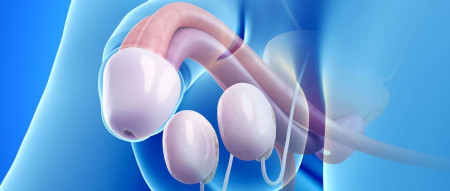Poltava, prospekt Vitaliia Hrytsaienka 9 Weekdays: 8:30-15:00, Weekend: weekend +38 (0532) 56-02-11+38 (095) 688 25 07
Types of implants and features of testicular prosthetics
 The main goal of prosthetics of one or both testicles is to achieve a satisfactory cosmetic effect against the background of orchiectomy, volvulus or congenital abnormalities of this organ. After surgical removal of the testicle, as in congenital conditions such as mono-, anorchia and cryptorchidism, asymmetry occurs, which can negatively affect the physical comfort and psychological health of a man.
The main goal of prosthetics of one or both testicles is to achieve a satisfactory cosmetic effect against the background of orchiectomy, volvulus or congenital abnormalities of this organ. After surgical removal of the testicle, as in congenital conditions such as mono-, anorchia and cryptorchidism, asymmetry occurs, which can negatively affect the physical comfort and psychological health of a man.
Like many other reconstructive surgeries, prosthetics have a purely cosmetic effect that does not affect reproductive function. Nevertheless, for many patients, the appearance of these organs is important, and their visible defects can cause problems in the psychoemotional sphere.
For prosthetics, hypoallergenic and biologically inert implants made of special polymers are used. These prostheses follow the shape of the testicles, have a smooth surface and have good strength. In addition, after removing the stitches, the organ will not differ from the natural one both visually and tactilely.
Existing types of implants
During the operation, testicular implants are placed in a space that is located under the skin of the scrotum. Since prosthetics can be carried out for both children and adolescents and adults, implants are made in various sizes and are selected individually for the anatomical features of the patient. To do this, in the case of monorchia, they are guided by the size of the remaining testicle, and in the case of anorchia, by the size of the penis, the availability of tissues for plastic surgery and the constitution of the man.
For prosthetics, one of two types of implants is used:
- silicone - a safe prosthesis with a gel-like content, repeating the shape of the testicle;
- liquid - they are placed under the skin of the scrotum using a puncture. Dimethacrylate with water or sterile hydrogel is most often used as the main material for such implants.
The choice of the type of prosthesis and the method of its introduction is determined by the surgeon in consultation before the operation.
When is testicular prosthetics necessary?
The implantation of a prosthesis into the scrotum is indicated for pathologies and conditions characterized by the absence of one or two testicles. This includes congenital pathologies of the development of these organs, their removal after operations, trauma or severe inflammation, which led to their deformation.
 Such conditions are characterized by a violation of the psychological balance of a man and are often accompanied by uncertainty and problems in the sexual sphere, therefore, the cosmetic effect of such an intervention has a positive effect on the quality of life of these patients.
Such conditions are characterized by a violation of the psychological balance of a man and are often accompanied by uncertainty and problems in the sexual sphere, therefore, the cosmetic effect of such an intervention has a positive effect on the quality of life of these patients.
What are the methods of prosthetics?
At the moment, surgeons perform testicular prosthetics using two methods.
- Implantation with inguinal access. This surgical approach is carried out along the groin fold through the inguinal canal. If an atrophied testicle is preserved in the scrotum, it is removed, the spermatic cord is ligated and the implant is inserted into the scrotal cavity. The main visual landmark during this access is the spermatic cord - along it, a tunnel is formed through the scrotum.
- Implantation with scrotal access. In this case, the incision goes directly through the skin of the scrotum in its upper corner from the corresponding side. The implant is fixed at the bottom of the scrotum with absorbable Vicryl sutures, and the sutures are made with the same sutures. The use of this material allows you to minimize complications associated with the presence of foreign materials in the tissues, as well as leave no noticeable traces after the operation. The stitches completely dissolve in two months.
What is the difference between the operation in adults and children?
Prosthetics can be performed for both children and adults and adolescents. For children, this operation is recommended before puberty with a further replacement of the implant with a different size in adolescence. Common indications for surgery in childhood and adolescence are anorchia, cryptorchidism, and sometimes testicular volvulus.
One of the features of testicular prosthesis implantation in children and adolescents is the careful selection of the implant size. Using an oversized prosthesis is fraught with tissue necrotization with further implant loss.
For testicular prosthetics in adolescents, it is considered optimal to use an inguinal operative access and further suturing of the inguinal canal from the side of the scrotum. The best age for prosthetics in this age group is considered to be between 16 and 18 years old - in this case, the risk of complications is minimal. If prosthetics are necessary after orchiectomy, it is better to do it six months or a year after such an operation.
Operation in adults is possible at any age, provided there are indications and no contraindications. After the operation, the patient remains under observation for some time in a hospital setting, and then receives a recovery program for the rehabilitation period. To prevent suture divergence and complications associated with their infection, it is recommended to abandon excessive physical activity and sexual intercourse before they are removed.
specialists of the Clinic for Plastic Surgery
18-06-2021
Similar news
